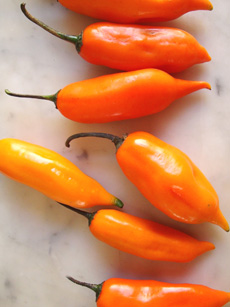TIP OF THE DAY: Ají Sauce
|
Hot sauce lovers should take a closer look at ají sauce, a standard in Ecuador and Peru. Aji amarillo is one of the most common types of chiles in the area, and is also one of the most important ingredients in the two countries.
While, like all salsas, there are as many variations as there are cooks, a basic ají criollo is made from the ají amarillo (yellow ají*), along with cilantro, garlic, onion and lime. Each region and city has its own unique recipe. For example, ají de tomate de árbol—tree tomato or tamarillo ají—uses tamarillo as well as ají amarillo. (A recipe is below.) Andrés Dávila, executive chef of Casa Gangotena, TripAdvisor Travelers’ Choice Top Ten Hotel, offers tourists a journey through the different types of ají, with a selection of six sauces carefully paired with a dish that heightens the flavors of the local cuisine. He’s also sent us a standard recipe so you can make your own. Great for sauces and to kick up any meal with a great flavor and medium heat. Chewing on the chiles adds more heat. |

Ají amarillo, in shades of yellow and orange. Photo courtesy PeruDelights.com. |
|
|
You can probably find a jar of ají paste in the Latin foods section of your supermarket. Goya makes it, of course, and you can find specialty brands such as Costa Peruana and Inca’s Food online. Aji paste is simply a purée of fresh ajis. “American fusion” uses include: |
||
 Add bold flavor to many dishes with ají amarillo (yellow chile) paste. Photo courtesy Inca’s Food. |
RECIPE: HOMEMADE AJÍ SAUCE This classic ají sauce combines tree tomato (tamarillo), ají amarillo and chochos (lupines, or lupin beans). Lupins are a large yellow Italian bean. You can substitute lima beans or fava beans for the lupins. Ingredients |
|
|
Preparation 1. PEEL the tomatillos and boil them for 5 minutes. 2. BLEND the tomatillos with ají chiles. For a milder sauce, seed and devein the chiles. You can always save a few seeds and add them in if it’s too mild. 3. TRANSFER the mix to a small sauce pan, add the water (you can add more if you want a more liquid sauce) and cook on medium heat for 5-8 minutes. You can also skip the cooking part; the sauce will be fresher in taste, but will need to be consumed more quickly. 4. ADD the onion, lime juice, cilantro, optional chochos and salt to taste. Serve warm or cold. VARIATION: Replace the water with oil (avocado, light olive oil or a mild flavored oil) for a creamier Cuencano-style ají, and do not cook it after blending. Recipe courtesy Laylita.com. |
||


